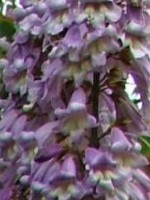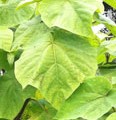 Also known as princess tree and foxglove-tree, this flowering deciduous tree belongs to the Paulowniaceae family and is a native of central and western China but has is cultivated in North America where it has become invasive in places . It is a compact, low-branching, wide-spreading tree with a rounded canopy and large bright green heart-shaped leaves up to sixteen inches across. The catalpa-like leaves may be lobed, and are lightly hairy above and densely hairy beneath earning the plant the specific epithet, tormentose meaning soft wooly hairs. In spring before the leaves unfold, large clusters of vanilla-scented, violet-blue flowers appear. The clusters are six to ten inches long, and the tubular foxglove-like flowers are 1.5 to 2 inches long and have creamy yellow stripes and dark purple spots in the inside. In autumn the flowers are followed by oval, light-brown, woody capsules, 1 to 1.5 inches long. Each capsule contains up to 2000 winged seeds and persists into winter after the leaves fall. Empress tree is tolerant of drought and air pollution but is not shade tolerant and needs protection from the wind. It puts on a spectacular show when in bloom and is a good choice for a specimen tree. The generic name, Paulowna, and common names, empress tree and princess tree, refer to Princess Anna Paulowna (1795-1865), daughter of Czar Paul I of Russia.
Also known as princess tree and foxglove-tree, this flowering deciduous tree belongs to the Paulowniaceae family and is a native of central and western China but has is cultivated in North America where it has become invasive in places . It is a compact, low-branching, wide-spreading tree with a rounded canopy and large bright green heart-shaped leaves up to sixteen inches across. The catalpa-like leaves may be lobed, and are lightly hairy above and densely hairy beneath earning the plant the specific epithet, tormentose meaning soft wooly hairs. In spring before the leaves unfold, large clusters of vanilla-scented, violet-blue flowers appear. The clusters are six to ten inches long, and the tubular foxglove-like flowers are 1.5 to 2 inches long and have creamy yellow stripes and dark purple spots in the inside. In autumn the flowers are followed by oval, light-brown, woody capsules, 1 to 1.5 inches long. Each capsule contains up to 2000 winged seeds and persists into winter after the leaves fall. Empress tree is tolerant of drought and air pollution but is not shade tolerant and needs protection from the wind. It puts on a spectacular show when in bloom and is a good choice for a specimen tree. The generic name, Paulowna, and common names, empress tree and princess tree, refer to Princess Anna Paulowna (1795-1865), daughter of Czar Paul I of Russia.
 Type: Flowering deciduous tree
Type: Flowering deciduous tree
Outstanding Feature: Flowers, large tropical looking leaves
Form: Rounded compact canopy
Growth Rate: Very rapid
Bloom: Large clusters of vanilla-scented, violet-blue flowers in spring; clusters are six to ten inches long; foxglove-like flowers are 1.5 to 2 inches long, and have creamy yellow stripes and dark purple spots in the inside.
Size: 30-40’ H x 30-40’ W
Light: Full sun
Soil: Prefers deep, fertile, moist, well-drained soil but tolerates less.
Hardiness: Zones 5-8
Care: Prune annually in winter to shape (flowers on old wood)
Pests and Diseases: None of significance; buds may be killed by frost.
Propagation: Root cuttings; seed